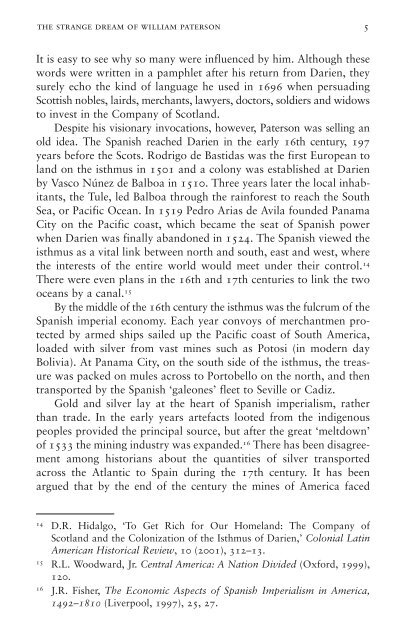You also want an ePaper? Increase the reach of your titles
YUMPU automatically turns print PDFs into web optimized ePapers that Google loves.
<strong>Price</strong> <strong>of</strong> <strong>Scotland</strong> B format_Layout 1 03/11/2020 11:09 Page 5<br />
the strange dream <strong>of</strong> william paterson 5<br />
It is easy to see why so many were influenced <strong>by</strong> him. Although these<br />
words were written in a pamphlet after his return from Darien, they<br />
surely echo the kind <strong>of</strong> language he used in 1696 when persuading<br />
Scottish nobles, lairds, merchants, lawyers, doctors, soldiers and widows<br />
to invest in the Company <strong>of</strong> <strong>Scotland</strong>.<br />
Despite his visionary invocations, however, Paterson was selling an<br />
old idea. <strong>The</strong> Spanish reached Darien in the early 16th century, 197<br />
years before the Scots. Rodrigo de Bastidas was the first European to<br />
land on the isthmus in 1501 and a colony was established at Darien<br />
<strong>by</strong> Vasco Núnez de Balboa in 1510. Three years later the local inhabitants,<br />
the Tule, led Balboa through the rainforest to reach the South<br />
Sea, or Pacific Ocean. In 1519 Pedro Arias de Avila founded Panama<br />
City on the Pacific coast, which became the seat <strong>of</strong> Spanish power<br />
when Darien was finally abandoned in 1524. <strong>The</strong> Spanish viewed the<br />
isthmus as a vital link between north and south, east and west, where<br />
the interests <strong>of</strong> the entire world would meet under their control. 14<br />
<strong>The</strong>re were even plans in the 16th and 17th centuries to link the two<br />
oceans <strong>by</strong> a canal. 15<br />
By the middle <strong>of</strong> the 16th century the isthmus was the fulcrum <strong>of</strong> the<br />
Spanish imperial economy. Each year convoys <strong>of</strong> merchantmen protected<br />
<strong>by</strong> armed ships sailed up the Pacific coast <strong>of</strong> South America,<br />
loaded with silver from vast mines such as Potosi (in modern day<br />
Bolivia). At Panama City, on the south side <strong>of</strong> the isthmus, the treasure<br />
was packed on mules across to Portobello on the north, and then<br />
transported <strong>by</strong> the Spanish ‘galeones’ fleet to Seville or Cadiz.<br />
Gold and silver lay at the heart <strong>of</strong> Spanish imperialism, rather<br />
than trade. In the early years artefacts looted from the indigenous<br />
peoples provided the principal source, but after the great ‘meltdown’<br />
<strong>of</strong> 1533 the mining industry was expanded. 16 <strong>The</strong>re has been disagreement<br />
among historians about the quantities <strong>of</strong> silver transported<br />
across the Atlantic to Spain during the 17th century. It has been<br />
argued that <strong>by</strong> the end <strong>of</strong> the century the mines <strong>of</strong> America faced<br />
14<br />
D.R. Hidalgo, ‘To Get Rich for Our Homeland: <strong>The</strong> Company <strong>of</strong><br />
<strong>Scotland</strong> and the Colonization <strong>of</strong> the Isthmus <strong>of</strong> Darien,’ Colonial Latin<br />
American Historical Review, 10 (2001), 312–13.<br />
15<br />
R.L. Woodward, Jr. Central America: A Nation Divided (Oxford, 1999),<br />
120.<br />
16<br />
J.R. Fisher, <strong>The</strong> Economic Aspects <strong>of</strong> Spanish Imperialism in America,<br />
1492–1810 (Liverpool, 1997), 25, 27.


















